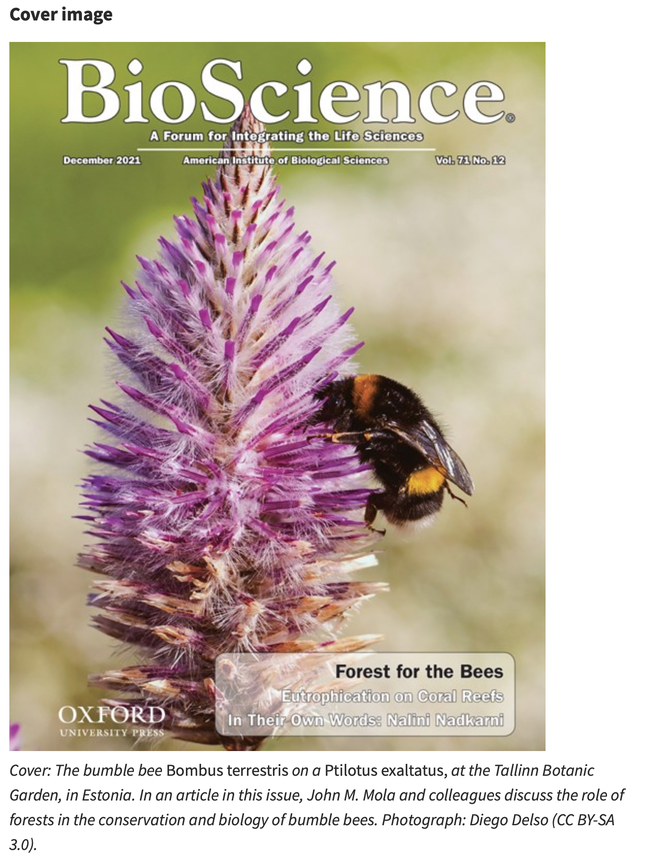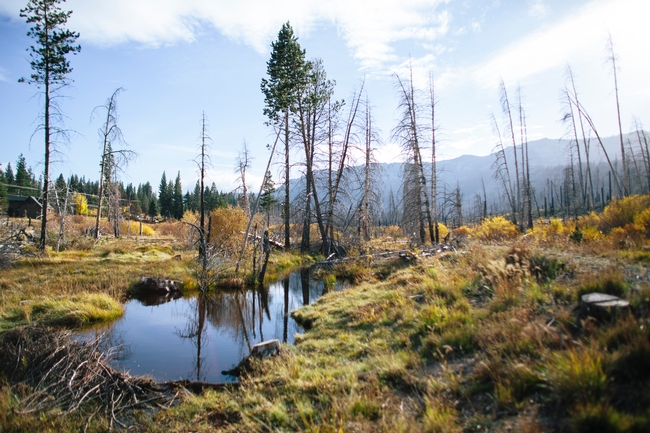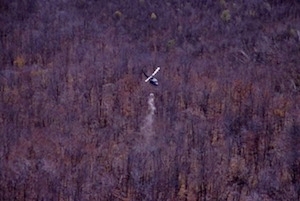Posts Tagged: forests
Do Forests Play a Role in Bumble Bee Life History?
Do forests play a role in bumble bee life history? Yes, says UC Davis alumnus and research ecologist John Mola and his colleagues in...

The cover image of BioScience by Diego Delso shows a Bombus terrestris, a buff-tailed bumble bee that is one of the most numerous bumble bee species in Europe.
New project to build climate resilience through improved land management
A $4.6 million grant to UC Merced and UC Irvine will help UC Agriculture and Natural Resources researchers develop new tools and methods for California land owners to better manage the state's forests, shrub lands and grasslands.
California's Strategic Growth Council agreed to fund the Innovation Center for Advancing Ecosystem Climate Solutions, a three-year program co-led by UC Merced Professor Roger Bales and UC Irvine Professor Michael Goulden. The money comes through California Climate Investments, a statewide initiative that puts billions of cap-and-trade dollars to work
The goals include reducing wildfire risk, improving long-term carbon sequestration and bolstering resilience in the face of climate change, with an emphasis on California's rural regions and low-income communities.
“Our part of the project is to work with stakeholders and identify areas where we can focus management practices to promote healthy forests, minimize wildfires, improve water security and increase carbon sequestration,” said Toby O'Geen, UC Cooperative Extension soil resource specialist at UC Davis.
“Right now, many of California's forests, shrub lands and grasslands are carbon sources, and we need to change them into carbon sinks,” said Bales, director of the Sierra Nevada Research Institute and distinguished professor of engineering. “Our research will address information bottlenecks to guide decision making, build local capacity for science-based land management and develop methods for translating benefits of land restoration into financing for land restoration.”
California's recent drought, tree die-offs, wildfires and rising temperatures all point to the necessity of improved forest stewardship, Goulden said.
“Officials in the state government and agencies recognize this need, but uncertainty over how to proceed has sometimes slowed progress,” he said.
Most of the work will be conducted by scientists at Merced and Irvine, but collaborators from UC Berkeley, UC Davis, Stanford University, San Diego State University and the University of California Division of Agricultural and Natural Resources, as well as state agencies, will play important roles.
“This research will enable UC Cooperative Extension advisors to provide better advice to land managers to reduce the severity of wildfires,” said Glenda Humiston, UC vice president for agriculture and natural resources. “Severe wildfires are not only releasing greenhouse gases, but polluting the air of many communities, aggravating the health of people in less-affluent, inland areas such as Tulare, Yuba and Mariposa counties.”
At UC Merced, an interdisciplinary group of researchers from two departments — Civil & Environmental Engineering and Management of Complex Systems — will collaborate with UC Cooperative Extension and engage with local stakeholders. The group will study and identify the most-effective land-management practices, in terms of water conservation, forest health, fire resistance and carbon capture.
“We will develop the spatial data and analysis tools to plan landscape restoration, develop local capacity for better managing the state's wildlands in a warming climate, and enumerate the greenhouse gas and other benefits from investments in land management,” Bales said.
Goulden, professor of Earth systems science, said UC Irvine researchers will use a big-data approach to analyze observations collected by satellites since the 1980s to measure the efficacy of thousands of past and ongoing forest treatments, while UC Merced takes a different approach.
“We will work with groups in rural communities to systematically evaluate how well, or poorly, our products can support decision making,” Bales said, “and then develop both implementation pathways and policy recommendations to better and more-quickly implement landscape-restoration and carbon-capture projects across the state.”
Because there are critical gaps in the understanding of carbon cycles, uptake by forests and negative feedback from climate change, this project initiative has been established to develop new knowledge through measurements and modeling. Researchers will synthesize the resulting data to produce actionable information for stakeholders.
Bales and Goulden agreed the Innovation Center will target low-risk, high-yield opportunities to reduce California's greenhouse-gas contributions.
Just a small improvement in management efficiency will have meaningful benefits — on the order of several million metric tons of CO2 per year, Goulden said.
The program will also benefit low-income communities in the state by reducing wildfire risk, which disproportionately impacts poorer areas in California; by maintaining water quantity through better vegetation management; by fostering tourism in disadvantaged locales; and by preparing students in these areas for careers in sustainability and climate resilience.
Recycling Christmas trees helps curb the spread of pests
If you have a real Christmas tree, University of California pest management experts ask that you to recycle the tree to prevent the spread of insects and diseases that may harm our forests and landscape trees.
“Invasive insects, diseases and plant seeds can move on cut Christmas trees and other holiday greenery,” said Janice Alexander, UC Cooperative Extension forest health educator in Marin County. “These pests can escape out into backyards and neighboring forests to begin new populations, upsetting the balance of our native ecosystems. Proper purchasing and disposal of holiday greenery helps reduce that risk.”
Alexander recommends taking advantage of local tree recycling programs.
“Many municipalities and service organizations offer this service right at your curb,” she said. “If you aren't able to find or use this option, take the tree to your local solid waste facility, dump or landfill. This will keep any pests that might be in the tree from spreading and the landfill uses the material as cover.”
“You should not try to burn the wood indoors as fresh sap can create fire hazards,” she added, “and don't set the tree out in a backyard brush pile where pests and weed seeds could escape onto your property.”
“The most worrisome pests that might be traveling on Christmas trees or greenery this year include P. ramorum, pine shoot beetle and gypsy moth,” Alexander said.
The movement of some fresh trees is regulated. For example, Douglas fir trees are regulated because they are hosts for Phytophthora ramorum, which causes sudden oak death. The disease has killed millions of tanoak trees and several oak tree species in forests throughout California since the mid-1990s.
Pine shoot beetle and gypsy moth are not currently in California, but they could damage the state's Christmas tree plantations and forests if they were to become established.
Pine shoot beetles, Tomicus piniperda, feed on shoots, stunting the growth of pine trees. Large populations of the insects can kill apparently healthy trees.
Gypsy moth, Lymantria dispar, attacks forests and landscape trees, including manzanita, western hemlock, Douglas fir and live oak. Gypsy moth caterpillars feed on hundreds of plant species and are capable of defoliating trees at an alarming rate. A single gypsy moth caterpillar can eat up to one square foot of leaves per day, according to the California Department of Food and Agriculture.
For more information about sudden oak death and forest health, visit Alexander's website at http://cemarin.ucanr.edu/Programs/Custom_Program816. More information about holiday greenery pests can be found at the USDA APHIS website and the Don't Move Firewood website http://www.dontmovefirewood.org/HolidayGreenery.
Got calcium? Mineral key to restoring forests
Calcium can do much more than strengthen bones. The mineral is a critical nutrient for healthy tree growth, and new research shows that adding it to the soil helps reverse the decades-long decline of forests ailing from the effects of acid rain.
“It is generally accepted that acid rain harms trees, but the value of our study is that it proves the causal link between the chronic loss of soil calcium caused by decades of acid rain and its impact on tree growth,” said Battles. “The temporal and spatial scope of the study – 15 years and entire watersheds – is unique and makes the results convincing.”
The researchers reported that trees in the calcium-treated watershed produced 21 percent more wood and 11 percent more leaves than their counterparts in an adjacent control site. The iconic sugar maple – the source of maple syrup – was the tree species that responded most strongly to the restoration of calcium in the soil.
Acid deposition has altered the calcium cycle in watersheds in the Northeastern United States in ways that are similar to changes observed at Hubbard Brook Experimental Forest.
The research site, managed by the U.S. Forest Service, was targeted because of the declining growth rates and unexpected death of trees in the area. Previous measurements of the forest soil showed a 50 percent depletion of calcium.
Acid rain forms when sulfur dioxide and nitrogen oxides – gases produced from the burning of fossil fuels – react with water molecules in the air. The mountainous regions in the Northeast have thin soils that are already acidic, so they have limited ability to withstand the assaults of nutrient-dissolving acid rain. Moreover, watersheds along the eastern corridor of the United States had been exposed to more acid rain because of the greater number of coal-burning power plants in the region.
For the Hubbard Brook study, a helicopter spread 40 tons of dry calcium pellets over a 29-acre watershed over several days in October 1999. The calcium was designed to slowly work its way into the watershed over many years.
“This was restoration, not fertilization,” said Battles. “We were only replacing what was lost.”
Researchers monitored the forest over the next 15 years, comparing the treatment area with an adjacent watershed that had the same characteristics, but did not get the added calcium.
“The treatment increased the forest’s resilience to major disturbances,” said Battles. “The trees in the calcium-treated watershed were able to recover faster from a severe ice storm that hit the region in 1998.”
“This study has important implications that go well beyond the forests of the northeastern United States,” said Dave Schindler, a professor of ecology at the University of Alberta in Canada who was not part of this research. “Similar depletion of soil nutrients by acid precipitation has occurred in much of eastern Canada and Europe. This long-term study indicates that the calcium problem can be reversed, and that is heartening.”
Both Schindler and Battles noted that the high cost of adding calcium to the soil would likely limit its use to targeted watersheds rather than as a treatment for vast areas of affected forests.
“Prevention is always preferable, and with our study’s clear evidence that acid rain is hurting forests, other countries will hopefully be motivated to intervene sooner by implementing air pollution standards to reduce emissions,” said Battles.
Funding from the National Science Foundation helped support this research.
RELATED INFORMATION
- Acid Rain Revisited (Hubbard Brook Research Foundation)
- Effects of Acid Rain – Forests (U.S. Environmental Protection Agency site)
Evidence of rodenticide poisoning of wildlife found in the Sierra
There is a new predator in the forest these days. It has arisen quietly over the years. Any wildlife feeling hungry when they come upon it in the Sierra is vulnerable. This predator is amazingly small for the scope of its damage; it can’t run fast or climb high.
University of California scientists originally became aware of this problem when Rick Sweitzer, associate professor in the Department of Environmental Science, Policy and Management at UC Berkeley, and his wildlife research team retrieved a radio-collared fisher whose cause of death was unclear. Sweitzer and his team are researching are studying the fate Pacific fishers as part of the Sierra Nevada Adaptive Management Project (SNAMP).
Necropsy (an autopsy for animals) of the fisher carcass by Mourad Gabriel of UC Davis and the Integral Ecology Research Center found rodenticide poisoning to be the cause. With these new findings, the livers from previous fisher mortalities in the SNAMP study were reexamined for evidence of rodenticide exposure. They discovered that more than 80 percent of dead fishers examined had been exposed to rodenticide. These toxicants can persist in animal tissues or the environment for potentially hundreds of days. At least five dead fishers found by researchers in SNAMP and a second fisher study in northern California have been confirmed to have died of rodenticide poisoning, the scientists reported in the science journal PlusOne.
Considering the hundreds of marijuana grow sites found every year on public lands, the scale of the damage to California’s natural resources may be unprecedented. Grow sites are also found containing massive amounts of fertilizers, herbicides and pesticides, all of which are being used without concern for run off or aquatic species nearby. Marijuana plants are removed from these plots when found, but these chemicals are often left behind.
Although this problem might seem overwhelming, there are efforts to address it. The non-profit Environmental Reclamation Team has cleaned up hundreds of grow sites since 2005. They remove and document all of the poisons found along with the miles of plastic irrigation line and piles of trash. More efforts like this are needed if we are to maintain rare animals like the Pacific fisher as well as all the other species who have the potential of coming in contact with these poisons.









